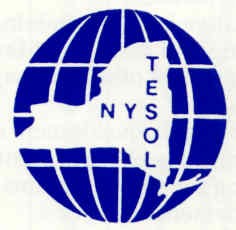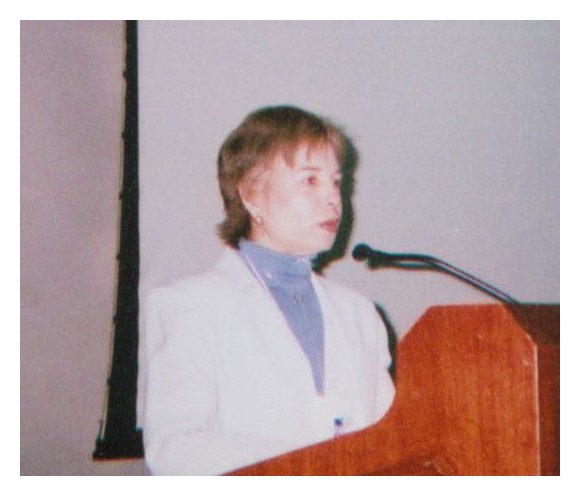
April 2003
Report from New Jersey: Keynote
KATESOL Spring Conference
NYS ODMAC April 26th
![]()
/ Index /
/ Letters /
/ Search /
![]()
Subscribe
for free!
Why We Need a Bilingual LD Certification
Report: Interventions and Assessments
The first session was a Keynote Address, "Research-based Interventions
and Assessment Procedures," by Elizabeth Franks and Barbara Tedesco,
who since the early 1990s have spearheaded efforts to raise awareness in
New Jersey and nationally regarding procedures for sorting out special
needs and language learning needs. ESL/Bilingual and Special Education
professionals "need to be on the same page," said Franks. "We need to
work together to build a process to communicate and dialogue for
the child."
Franks and Tedesco introduced three levels of interventions: systemic,
instructional and individual. At the systemic level, they reported, an
accepting and supportive school environment is characterized by:
All elements of a school community--janitors, cafeteria workers,
administrators, teachers--are involved in establishing signs of
welcomeness to culturally and linguistically diverse children,
according to Barbara Tedesco, who added, "it's not just for
World Nations Week." Tedesco recounted how a school
with a small population of English language learners did
training for bus-drivers and cafeteria workers on "how to
help children feel accepted, not left out."
The Need For Skilled Training of All Teachers
According to Elizabeth Franks, Bilingual/ESL
Supervisor for Roselle Public Schools , what is needed
is a bilingual program and "skilled training not just of
ESL teachers but any teacher who comes in contact
with the ELL student." Barbara Tedesco, Principal at Harrison
School, of the Roselle Public Schools, added that one
good idea is to do mini-sessions, bringing in content
teachers. "These can be done by teachers themselves," she suggested.
"It doesn't always require administration."
Another important aspect of interventions at the
systemic level on behalf of English language learners,
according to Franks, involves all of us realizing that
"what they bring to the classroom is valued, that
these students are not empty slates when they
arrive." Culturally and linguistically diverse students
can be like a window, or a mirror, explained Franks,
who suggested teachers ask themselves, "How can
I tap into and use what the child brings to the classroom?"
Even something as seemingly simple as pronouncing
new students' names correctly is crucially important,
according to Tedesco. "This can be a workshop in and of itself
for more than one hour," she said. "If there is a need to change
names," Tedesco added, "make it a decision to share with
the caregivers or parents."
The key questions to ask in advocating for systemic reform,
said Elizabeth Franks, are:
The Importance of An Initial Assessment in L1
Franks and Tedesco both emphasized the importance
of getting an initial assessment of how a new student
is functioning in his or her first language, L1. "This is
crucial information at the start," explained Franks. "If
a kid comes in functioning at grade level in L1, and three
years later is not at grade level in either L1 or L2, we
need to be in a position to ask: what happened?"
In addition to an IDEA proficiency test (IPT), she
explained, schools need to add a component
in the child's L1. "It is critical that this be part
of the school's initial interaction with the child,"
she said, "because years down the line,
after no instruction in L1, it will be tough to get
this information to help in making an assessment."
At the instructional level, the mission must be for all teachers to use
instructional strategies effective for English language
learners, according to Barbara Tedesco and Elizabeth
Franks. They believe that the "Five Standards for
Effective Pedagogy," from CREDE (Center for Research
on Education, Diversity & Excellence), are central
to fulfilling that mission. Those five standards are:
"Document, Document, Document...Train, Train, Train"
In addition to the selection of effective instructional
strategies, each teacher must use a clinical teaching cycle
in a continual effort to either resolve learning difficulties
or validate the existence of a learning problem, or both.
This clinical teaching cycle, according to Tedesco and Franks, requires assessment of
a difficulty, followed by teaching using significantly
different strategies which take into account various
learning styles and multiple intelligences. After each
new effort to teach using a different strategy, teachers
need to test again. The key, according to Barbara Tedesco,
is "document, document, document, and train, train, train."
A further crucially important factor, said Elizabeth Franks,
is that a clinical teaching cycle "requires that, systematically,
time is allocated to these processes."
If systemic and instructional interventions have been
tried and learning difficulties are not yet resolved,
it is time to seek support systems at the individual
level, according to Franks and Tedesco. Consultations
via Parent Advisory Councils are conducted to gather
relevant data on the student, including attendance,
grades, achievement in both languages, classroom observations,
length of time in the district or country, and mobility.
When looking at grade level, said Franks, "you need to
look at actual as well as functional levels." It is
also important to watch the child in different settings,
she explained, not only in the classroom. Other options
for intervention at the individual level,
according to Barbara Tedesco and Elizabeth Franks, include
Title I, counseling and community-based programs. One-on-one
tutoring can also be used to identify the exact weakness
and find strategies to address the deficiency."We don't
know what is happening in the lives of many of our students,"
Franks continued. "Unless we know that affective filter
is really down, nothing we can do will help."
The Transition from Prereferral to Referral
Only after various combinations of systemic, instructional
and individual interventions have failed to help a student
learn in a new school is it time to begin a referral process,
according to Franks and Tedesco. If the problem persists,
explained Tedesco, a special education referral is initiated,
with a summary of all the interventions and relevant data
to accompany the referral. "With these interventions in
place, I feel more confident," she said. "If things are
being done according to a process, then you have everything
to feel right about. It shouldn't have to get to the point
of an OCR (Office of Civil Rights) order."
Tedesco and Franks went into a fair amount of
detail regarding the role of a Child Study Team
in determining the appropriate language for the
child to be assessed in. The first task for
the Child Study Team is to determine and document
the child's dominant language. "You need to compare
both languages to determine dominance," Elizabeth
Franks reminded the audience. One test she recommended
was the Bilingual Verbal Abilities Test, co-authored
by Jim Cummins and published by Riverside, a test
available for comparing proficiency in English with
proficiency in 15 different languages. "You can look
at tests like this paired with something prepared
locally," suggested Franks.
If a child is dominant in his or her first language,
the recommendation will be for the child to be tested
in the first language, Franks and Tedesco explained,
but you will also need to test in English. If the
child is dominant in English, they said, the school
should still consider the first language in doing
cognitive assessments. "You want this information about
the child in both languages," said Tedesco. "If you
don't use bilingual assessment, you will never know
for sure whether it's a learning disability or a language
learning problem."
The Child Study Team would ideally include someone
with a certification for Bilingual Learning Disabilities,
according to Tedesco, but this certification program
does not yet exist in New Jersey. "It's so important
to know information about the child's first language,"
she reiterated.
If the Child Study Team decides that a comprehensive
evaluation of the child is justified, there are two
new questions to answer. First, an assessment battery
needs to be selected. If the assessment is available
in the child's native language, he or she should be
assessed in that language as well as in English, according
to Tedesco and Franks. They also recommend that there
be informal as well as formal tests used in the assessment.
"You cannot depend on standardized testing for English
language learners," stressed Tedesco. There should also
be curriculum-based assessments, she added.
The Role of Adaptations in the Evaluation Process
The second important area to consider when putting
together the comprehensive evaluation procedure for
a culturally and linguistically diverse student concerns
adaptations. In most instances, adaptations will entail
the involvement of additional personnel for the assessment
process, according to Franks and Tedesco. The school and
district will need to contract the services of a bilingual
professional and may need to do any or all of the following
trainings for those who assist in the process:
"In all instances, train your assessment personnel,
whether monolingual or bilingual," advised Barbara Tedesco.
Interpreters need training in "how not to put your own
opinion into the mix," she explained, and training for
all assessment personnel needs to include areas such
as "not letting people lose face" and legal issues and
roles.
Where Learning Disabilities Diverge From Language Acquisition
Franks and Tedesco suggested a few standard assessment
adaptations: removing time limits; varying the mode
of response, for example reading selections to students
to check receptive skills, with an oral response; using
interpreters; and dynamic assessment, which means test,
teach and retest. They recommended Catherine Collier's
"Cross Cultural Developmental Education Services" Web site,
www.crosscultured.com,
for "wonderful materials for screening." Distinguishing
between adaptations for English language learning and those
for learning disabilities is integral to this process,
explained Barbara Tedesco. "That's why L1 data is crucial."
It is key that test results before modifications be
compared to test results after modifications, according
to Tedesco and Franks. "If the score improves with adaptations,"
explained Elizabeth Franks, "then the child is learning the
language." If the score does not improve with adaptations,
"then there could be a learning disability," she said.
Finally, the Individual Education Plan committee must
meet to determine eligibility for special services and,
if there is eligibility, develop the IEP and recommend
services for the child. According to Tedesco and Franks,
the IEP committee must review all the data in order to
determine if the student has a legally defined disability
and requires special education services. The IEP committee
also needs to provide assurances, based on the data,
"that the student's problems are not primarily the result
of language, culture or not having the opportunity to learn,"
said Franks. "We've got to tease out that the problem is not
a cultural and language difference."
When it comes to developing the IEP itself, the committee
needs to be certain that the document includes all of the
following items, according to Franks and Tedesco.
*present level of performance in L1 and L2
Then, the placement decisions for this student need
to provide services in the least restrictive environment
that addresses all needs. This responsibility
is going to include bilingual education services as well as
further decisions regarding which services will be provided
in "pull-out" settings and which in "inclusion" settings.
Report by Robb Scott, Hays, KANSAS
2003 ESL MiniConference Online
 On Friday, March 7th, 2003, about 125 educators, mostly
from in-state, attended the 3rd Annual "New Jersey Conference
on Culturally and Linguistically Diverse Exceptional Learners,"
co-sponsored by NJTESOL-NJBE and the Multicultural Education
Department at New Jersey City University. According to conference
chairs Elizabeth Franks (Bilingual/ESL Supervisor, Roselle Public
Schools) and Barbara Tedesco (Principal, Harrison School, Roselle
Public Schools), about 50 percent of this year's participants were
Bilingual/ESL educators and the other 50 percent, Special Education
professionals. Dr. Mihri Napoliello, Ed.D., Chairperson of the Department
of Multicultural Education at New Jersey City University, gave some
welcoming remarks to start off the event, and a number of students
and professors from NJCU participated, as presenters and guides.
On Friday, March 7th, 2003, about 125 educators, mostly
from in-state, attended the 3rd Annual "New Jersey Conference
on Culturally and Linguistically Diverse Exceptional Learners,"
co-sponsored by NJTESOL-NJBE and the Multicultural Education
Department at New Jersey City University. According to conference
chairs Elizabeth Franks (Bilingual/ESL Supervisor, Roselle Public
Schools) and Barbara Tedesco (Principal, Harrison School, Roselle
Public Schools), about 50 percent of this year's participants were
Bilingual/ESL educators and the other 50 percent, Special Education
professionals. Dr. Mihri Napoliello, Ed.D., Chairperson of the Department
of Multicultural Education at New Jersey City University, gave some
welcoming remarks to start off the event, and a number of students
and professors from NJCU participated, as presenters and guides.
*skilled use and training of teachers;
*linguistic and cultural incorporation;
*meeting AYP benchmarks based on NCLB;
*elimination of ineffective responses to failure, such as retention or low-level academics;
*support for interventions; and
*an initial assessment of each new student's L1
 "Culturally and linguistically diverse students need quality
programs from the moment they step into the district,"
said Elizabeth Franks, who believes that disaggregation
of data under "No Child Left Behind" is a great opportunity
for teachers to have input in improving a school's program.
The bottom line, according to Elizabeth Franks, is that
"our kids need access to the whole program." English
language learners are "trying to hit a moving target," she
explained, so ESL only is not enough. "The whole school
needs to get involved."
"Culturally and linguistically diverse students need quality
programs from the moment they step into the district,"
said Elizabeth Franks, who believes that disaggregation
of data under "No Child Left Behind" is a great opportunity
for teachers to have input in improving a school's program.
The bottom line, according to Elizabeth Franks, is that
"our kids need access to the whole program." English
language learners are "trying to hit a moving target," she
explained, so ESL only is not enough. "The whole school
needs to get involved."
Are they having access to the curriculum from the first day when they walk in?
 Retention is another related key issue. In New Jersey, noted
Franks, "a student by law is not to be retained solely for a language
problem." Retention policies are up to the school system, but should
answer the following questions:
Retention is another related key issue. In New Jersey, noted
Franks, "a student by law is not to be retained solely for a language
problem." Retention policies are up to the school system, but should
answer the following questions:
What kind of programs will we offer?
Will there be summer programs?
Will there be after school programs?
*Developing language and literacy across the curriculum
*Making meaning, or connecting to students' lives
*Teaching complex thinking
*Teaching through an instructional conversation
 One research-based instructional model suggested
by Franks and Tedesco in their keynote address at the
"Culturally and Linguistically Diverse Exceptional Learners"
conference was the Sheltered Instruction Observation Protocol,
or SIOP, often referred to as "sheltered English." They
also referred to "Reading First" initiatives such as
those recommended under NCLB, but warned teachers and
administrators that studies are still being done on what's
effective for English language learners. Whichever
instructional model is chosen, according to Barbara
Tedesco, "principals and adminstrators have to check
to see whether curriculum policies are being implemented,
need to be watchdogs."
One research-based instructional model suggested
by Franks and Tedesco in their keynote address at the
"Culturally and Linguistically Diverse Exceptional Learners"
conference was the Sheltered Instruction Observation Protocol,
or SIOP, often referred to as "sheltered English." They
also referred to "Reading First" initiatives such as
those recommended under NCLB, but warned teachers and
administrators that studies are still being done on what's
effective for English language learners. Whichever
instructional model is chosen, according to Barbara
Tedesco, "principals and adminstrators have to check
to see whether curriculum policies are being implemented,
need to be watchdogs."
*train other
bilingual professionals to assist;
*train community
professionals to serve as interpreters;
*train non-professionals
in the district as interpreters; and/or
*train community non-professionals as interpreters.
*annual goals for L1 and L2 (L2 meaning ESL)
*amount of time in each setting
*duration of services
*evaluation criteria
*persons responsible for implementation
*strategies appropriate to disability and language and culture
Robb@ESLminiconf.net